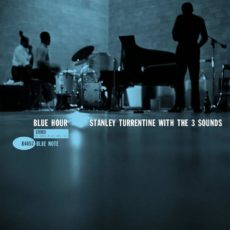
Requisites
Blue Hour ~ Stanley Turrentine With The Three Sounds | By Eddie Carter
In the hands of Stanley Turrentine, the tenor saxophone was an instrument of soulful creativity and immense power. From his 1960 debut, Look Out to his biggest hit, Sugar in 1971, Turrentine’s credentials were second to none as a giant of Hard-Bop, Modal, and Soul-Jazz. This morning’s choice from the library joins him with Gene Harris on piano; Andrew Simpkins on bass and Bill Dowdy on drums who were collectively known as The Three Sounds. Blue Hour (BLP 4057/BST 84057) was released in 1961 and is the second record where The Three Sounds backed a saxophonist, the other is 1959’s LD + 3 with Lou Donaldson. My copy used in this report is the 2015 Music Matters 33 1/3 Stereo audiophile reissue (MMBST-84057). I Want A Little Girl, written by Murray Mencher and Billy Moll in 1930 starts Side One. This infrequently heard ballad opens with an angelic introduction illustrating Harris’ attentiveness to the lyric and melody. Stanley brings a beautifully expressive sound and delicate sincerity to the opening chorus, then adds a graceful sensitivity to his solo. Gene’s interlude is brief but lovely and the closing by the quartet is captivating.
Gee Baby, Ain’t I Good To You was written in 1929 by Don Redman and Andy Razaf. Its first recording was by The King Cole Trio in 1943 and a year later, it became a hit for Nat King Cole and a jazz standard with numerous recordings to its credit. The Three Sounds provide a respectful treatment with a pensive introduction, allowing Turrentine to deliver the evocative theme with warm and affectionate feelings. The saxophonist also weaves a reverent spell of subtle lyricism on the opening solo. Harris is up next for the closer with a thoughtfully tender interpretation that speaks to the soul. The only original on the album ends the first side, Gene Harris’ Blue Riff takes the tempo to a medium beat during the first statement moving with a finger-popping, toe-tapping groove. The threesome states the melody, then Stanley takes over for a jubilant solo of vivacious spontaneity. Gene takes the next turn for a bouncy, bright presentation with a youthful spirit. Stanley returns for a few final compulsive choruses before the pianist takes the threesome into the fade-out.
Since I Fell For You by Buddy Johnson opens Side Two. He composed both the music and lyrics, introducing it in 1945 with his sister Ella on vocals. The Three Sounds start the song with a stylishly soft, slow-paced introduction as natural as if it was written for this quartet exclusively. This segues into a soothing opening melody by Turrentine who solos twice, putting his stamp on both interpretations displaying tranquil restraint on the first and closing statements. Harris contributes a tender reading that’s lovingly stated, anchored by Simpkins and Dowdy’s voluptuous foundation. Willow Weep For Me, written by Ann Ronell in 1932 begins with the exquisitely mellow tone of Stanley’s tenor sax having an intimate conversation with the rhythm section on the opening chorus. Gene’s first solo is elegant and laid-back, revealing its true beauty with gorgeous verses preceding an alluring climax. Stanley’s closing performance is soulful and bluesy like a leisurely walk on a warm summer evening with the trio proving the ideal companion to take the tune into a luscious coda.
Gene Harris, who was known for his gospel jazz style formed The Three Sounds in 1956 with Andy Simpkins and Bill Dowdy. The group became a hit with the public and when Blue Hour was recorded, the trio was amid a four-year run (1958-1962) recording a total of twelve albums for Blue Note including four in 1960 alone. The other three are Feelin’ Good, It Just Got To Be, and Moods. I believe that’s why Alfred Lion didn’t release the additional eight songs of this session on another album. The Three Sounds’ were together until 1970 when Harris left to embark on a successful solo career. Stanley Turrentine was a veteran of the Soul-Jazz style since the fifties and he recorded a total of seventeen LP’s for the label as a leader, plus several as a sideman with Donald Byrd, Kenny Burrell, Jimmy McGriff, Ike Quebec, Horace Parlan, Duke Pearson, Shirley Scott (who he was married to at the time), Jimmy Smith, and Art Taylor.
In his liner notes, noted author, jazz historian and journalist Ira Gitler offers one definition of the Blue Hour as that early morning time “when you reach across the pillow where your Baby used to lay” and find him (or her) not there. The sound quality is stunning, the remastering of Rudy Van Gelder’s original tapes by RTI Record Technology Incorporated is superb and the gatefold photos of each musician during the session compliments the music marvelously. This record is nearly thirty-nine minutes of enjoyable jazz by Stanley Turrentine and The Three Sounds that adds weight to any jazz library. It’s well worth auditioning for a spot in your library and an LP that’s perfect to enjoy any time of the day, evening, or early morning during the Blue Hour.
~ Feelin’ Good (Blue Note BLP 4072/BST 84072); Gee Baby, Ain’t I Good To You (Capitol 169); It Just Got To Be (Blue Note BLP 4120/BST 84120); LD + 3 (Blue Note BLP 4012/BST 84012); Look Out (Blue Note BLP 4039/BST 84039); Moods (Blue Note BLP 4044/BST 84044); Sugar (CTI Records CTI 6005) – Source: Discogs.com
~ I Want A Little Girl, Gee Baby, Ain’t I Good To You, Since I Fell For You, Willow Weep For Me – Source: Wikipedia.org
© 2020 by Edward Thomas CarterMore Posts: bass,choice,classic,collectible,collector,drums,history,instrumental,jazz,music,piano,saxophone


